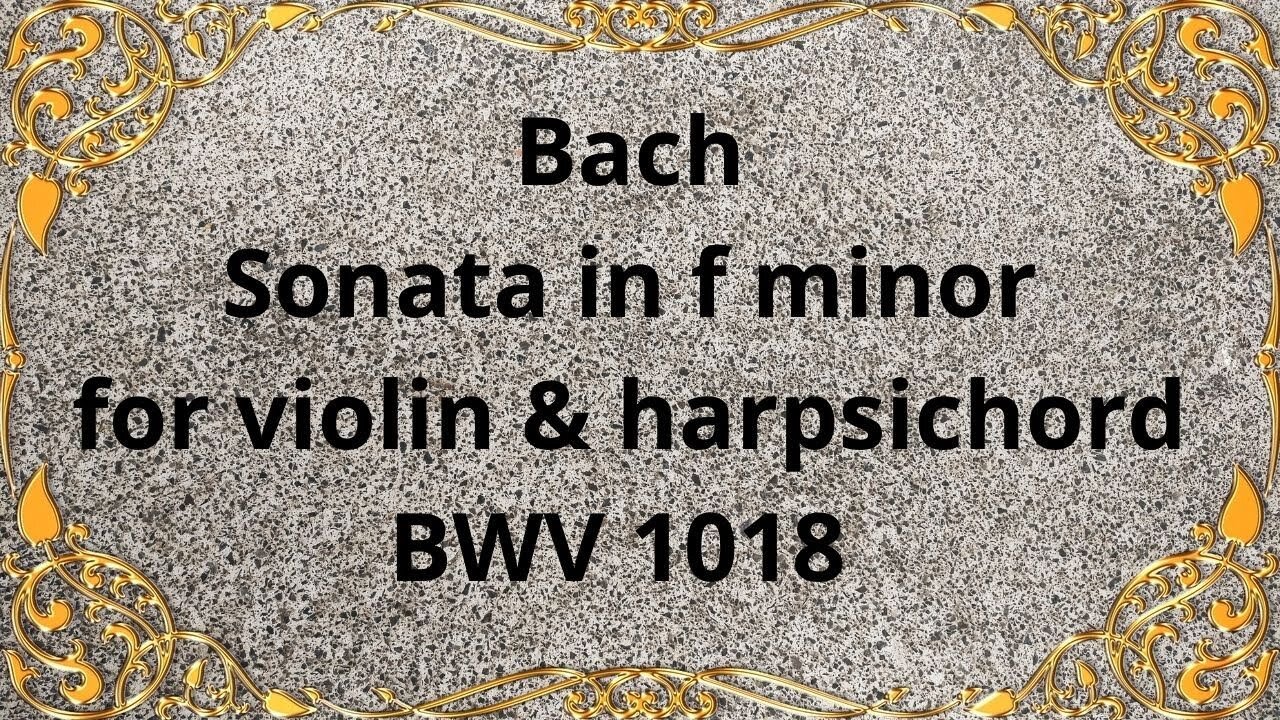Premium Only Content

Bach Sonata in f minor for violin & harpsichord, BWV 1018
Sonata in f minor for violin & harpsichord, BWV 1018
#Bach_Sonata #classical music #bach
Johann Sebastian Bach's Sonata in f minor for violin and harpsichord, BWV 1018, is a masterpiece of Baroque chamber music that showcases the composer's exceptional skill and artistry. The Sonata is part of a set of six sonatas for violin and harpsichord, composed in the early 18th century.
The Sonata in f minor is structured in four movements: Largo, Allegro, Adagio, and Vivace. The opening Largo is a somber and introspective movement that showcases the expressive capabilities of the violin and harpsichord. The Allegro that follows is a lively and energetic movement, full of technical challenges for both instruments. The Adagio is a slower movement, featuring a gentle and lyrical violin melody that is beautifully supported by the harpsichord. The final Vivace is a lively and upbeat movement that highlights the virtuosity of both instruments.
The Sonata in f minor is known for its intricate and complex musical features, including the use of counterpoint and the obbligato harpsichord part. Counterpoint involves combining different melodies to create a complex and harmonious texture. Bach was a master of counterpoint, and this is evident in the Sonata in f minor, where he creates intricate and beautiful harmonies between the violin and harpsichord.
The obbligato harpsichord part is also an important feature of the Sonata in f minor. The harpsichord provides both harmonic support and melodic material, making it an equal partner to the violin. Bach was one of the first composers to use the harpsichord in this way, and his influence on later composers can be seen in the works of Mozart and Beethoven.
In addition to counterpoint and the obbligato harpsichord part, the Sonata in f minor also features Bach's use of chromaticism. Chromaticism refers to the use of notes outside of the diatonic scale and is often used to create a sense of tension or dissonance. Bach's use of chromaticism in the Sonata in f minor adds depth and complexity to the music, creating a sense of drama and intensity.
Overall, the Sonata in f minor for violin and harpsichord, BWV 1018, is a masterpiece of Baroque chamber music. Bach's use of counterpoint, chromaticism, and the obbligato harpsichord part combine to create a rich and complex musical landscape. The Sonata in f minor remains a beloved and enduring work in the violin and harpsichord repertoire and is enjoyed by music lovers around the world.
-
 22:54
22:54
Classical music_Music Inspiration
11 days agoLudwig van Beethoven Quartet No. 6 in B-flat major, Op. 18 No. 6
302 -
 LIVE
LIVE
Gary Cardone
55 minutes agoLIVE With Gary Cardone
210 watching -
 LIVE
LIVE
Major League Fishing
3 days agoLIVE Tackle Warehouse Invitationals Championship, Day 3
171 watching -
 2:15:06
2:15:06
Game On!
18 hours ago $19.64 earnedNFL Week 1 Wise Guy Round Table BEST BETS!
109K2 -
 LIVE
LIVE
EXPBLESS
3 hours agoNew Game + On Elden Ring 🔥JOIN UP
167 watching -
 12:11
12:11
Nikko Ortiz
1 day agoCrashout 6 Rumble
56.1K8 -
 LIVE
LIVE
Midnight In The Mountains
5 hours agoGaming w/ PER·SE·VER·ANCE | Sunday Funday Split Screen Gameplay BL3
100 watching -
 24:39
24:39
GritsGG
19 hours agoINSANE Ranked Game on Warzone!
36.9K3 -
 LIVE
LIVE
MrR4ger
1 day agoWE BACK FROM VACAY MFKERS......THE HELL IS THIS? - HELL IS US
109 watching -

Joe Donuts Live
4 hours ago🟢 Squashing Bugs Like They Owe Me V-Bucks!
8.18K